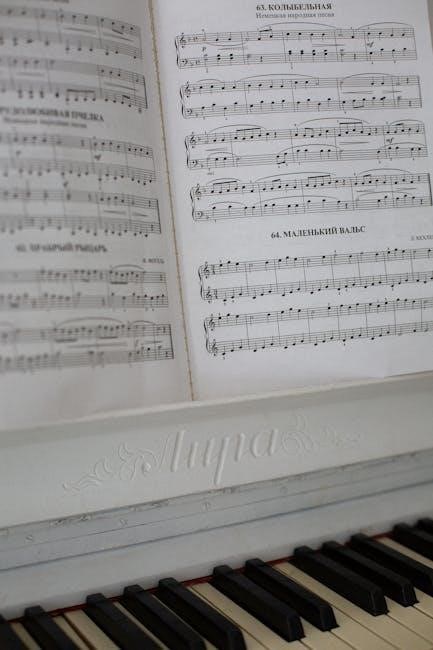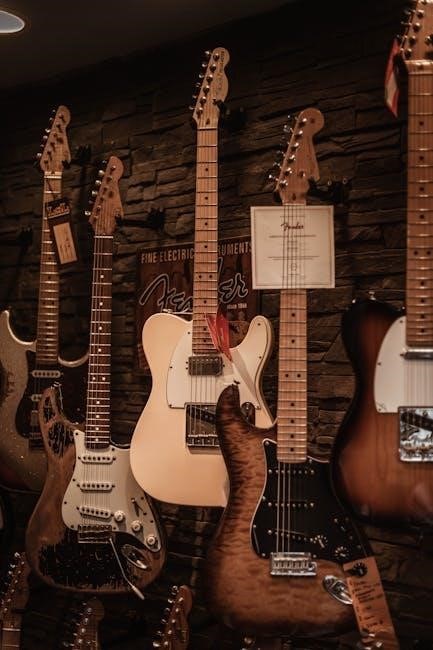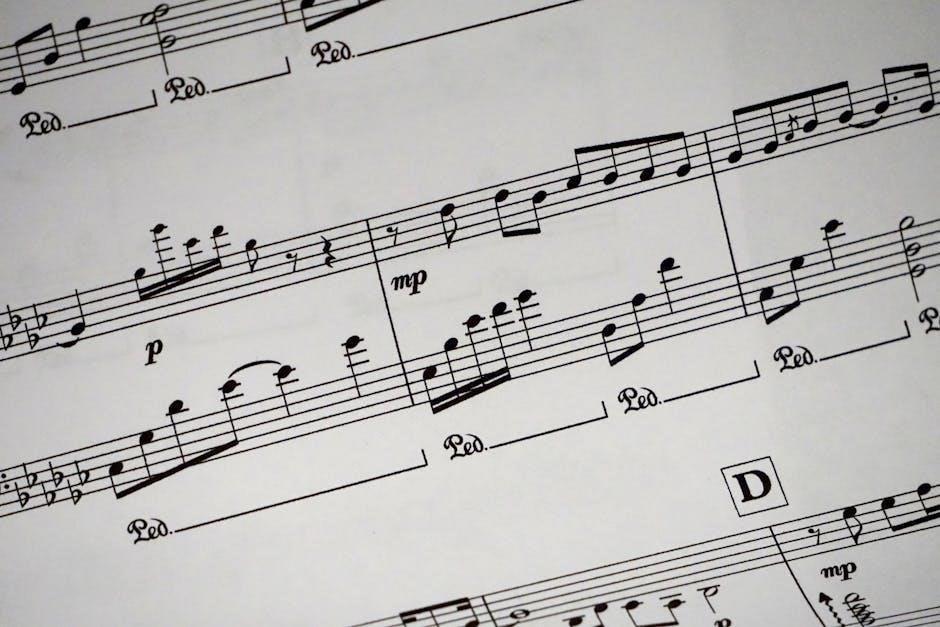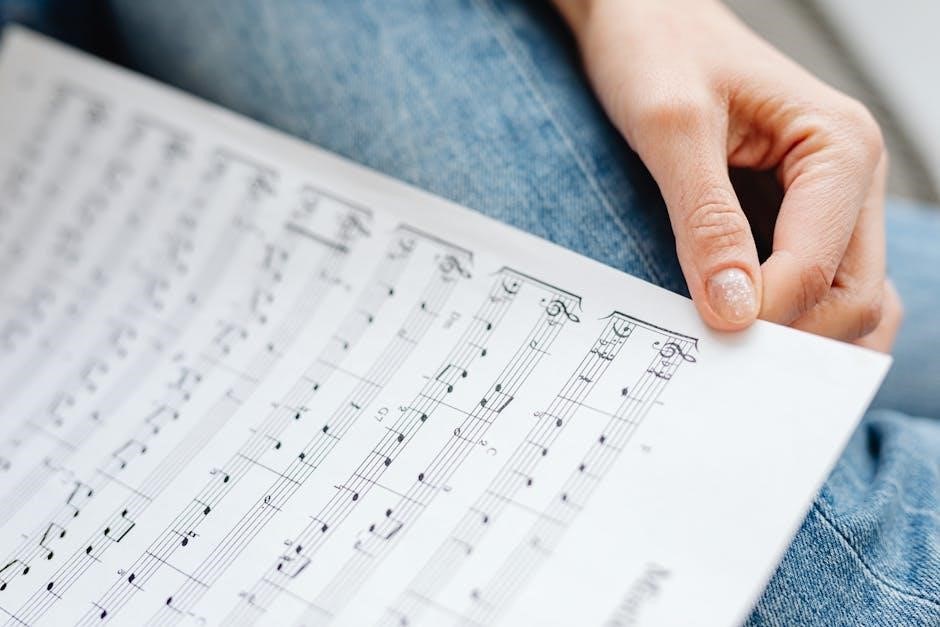Bass Clef Notes: A Comprehensive Guide
The bass clef, also known as the F clef, is crucial for notating lower-pitched musical notes. This guide helps piano players and music enthusiasts confidently read bass clef notes for confident playing. Understanding the bass clef unlocks musical potential.
Understanding the Bass Clef
The bass clef, often called the F clef, is a fundamental symbol in music notation, particularly for instruments in the lower register. It’s essential for reading music written for instruments like the bass guitar, cello, trombone, and the left hand of the piano. Unlike the treble clef, which focuses on higher pitches, the bass clef indicates the pitch of notes below middle C. The symbol itself features a curved line and two dots, which are positioned above and below the F line on the staff.
Learning to read the bass clef opens up a world of musical possibilities. It allows musicians to interpret and perform a wider range of music, especially music involving low-pitched instruments. By understanding the arrangement of notes on the bass clef staff, musicians can effortlessly translate written notation into sound, playing with enhanced accuracy and musicality. Mastering the bass clef is an investment that enriches a musician’s skill set.
The Staff and Ledger Lines in Bass Clef
The staff in bass clef, like in treble clef, consists of five lines and four spaces, upon which musical notes are placed to represent their pitch. Each line and space corresponds to a specific note in the bass range. The bottom line is G, and moving upwards, the lines are B, D, F, and A. The spaces between the lines, from bottom to top, are A, C, E, and G.
Notes that fall outside the standard five lines and four spaces of the staff require ledger lines. These are short lines added above or below the staff to extend the range of notated pitches. Ledger lines maintain the same spacing as the lines of the staff, ensuring accurate note representation. Understanding how to read notes on ledger lines is crucial for playing music with notes outside the staff’s range. This skill is essential for performing complex bass clef arrangements.

Reading Bass Clef Notes
Reading bass clef notes unlocks the lower register of music. Learning line and space notes, understanding mnemonics, and associating notes with the piano keyboard are crucial steps to master the bass clef.
Bass Clef Note Chart and Piano Keyboard Association
Understanding the relationship between bass clef notes and the piano keyboard is essential for musicians. A bass clef note chart visually connects each note on the staff to its corresponding key on the piano. This association builds a solid foundation for reading and playing music in the bass clef.
Reference charts are valuable tools for beginners, providing a quick way to identify notes. By studying these charts and practicing regularly, musicians can develop the ability to instantly recognize bass clef notes and translate them to the piano. This skill is crucial for sight-reading and playing bass lines. The combination of visual aids and practical application accelerates the learning process.
Mnemonics for Remembering Bass Clef Notes
Mnemonics are memory aids that can greatly assist in learning bass clef notes. These catchy phrases help associate notes with their positions on the staff, making the learning process more efficient and enjoyable. For the lines of the bass clef, a popular mnemonic is “Great Big Dogs From Africa”. Each word represents a note.
For the spaces, the mnemonic “All Cows Eat Grass” is commonly used. Remembering these mnemonics provides a quick way to recall the notes. Musicians can also create their own mnemonics. The key is to find phrases that are easy to remember and personally meaningful. Regular practice with mnemonics reinforces memory and accelerates note recognition.
Lines: Great Big Dogs From Africa
This mnemonic is designed to help you remember the notes that sit on the lines of the bass clef staff. Each word in the phrase “Great Big Dogs From Africa” corresponds to a note, starting from the bottom line and moving upwards. “Great” represents the note G, which is located on the bottom line of the staff.
“Big” corresponds to B on the second line, “Dogs” represents D on the middle line, “From” corresponds to F on the fourth line, and “Africa” represents A on the top line. This mnemonic is a simple trick to easily recall the notes G, B, D, F, and A. Practice visualizing the staff while repeating this phrase.
Spaces: All Cows Eat Grass
Just as we have a mnemonic for the lines, we also have a mnemonic to help remember the notes in the spaces of the bass clef. The phrase “All Cows Eat Grass” is a memorable way to associate each word with a specific note in the spaces, from the bottom space upwards. “All” represents the note A, which sits in the bottom space of the bass clef staff.
“Cows” corresponds to C in the second space, “Eat” represents E in the third space, and “Grass” represents G in the top space. By remembering this phrase, you can quickly identify the notes A, C, E, and G. This mnemonic is a simple, easy-to-remember tool for learning the bass clef notes.
Areas of the Bass Clef (C3 to C4)
To simplify reading bass clef notes, we can divide the staff into manageable areas. One such area includes notes ranging from C3 to C4. Understanding this area is fundamental for grasping the overall layout of bass clef notation, especially for piano. This section focuses on the notes within this range, their placement on the staff, and their corresponding keys on the piano keyboard.
The notes within this area provide a foundation for reading more complex musical passages. This knowledge can be reinforced using reference charts, which show the relationship between staff positions and piano keys. By mastering this area, you will have a solid basis for further exploration of bass clef notation.

Bass Clef Applications
The bass clef is essential in piano music, especially for the left hand, which typically plays lower notes. It’s also used for low-register instruments, expanding musical possibilities and arrangements for musicians.
Bass Clef in Piano Music (Left Hand)
For piano players, the bass clef is primarily associated with the left hand. The left hand typically plays notes in the lower register, providing the harmonic foundation and rhythmic drive for the music. Understanding the bass clef is vital for any pianist to master the complete range of the instrument. The left hand often handles bass lines, chords, and rhythmic patterns.
Bass clef notation allows pianists to read and perform these parts accurately. Proficiency in reading the bass clef opens the door to a vast repertoire of piano music, from classical compositions to contemporary pieces. Mastering bass clef reading enhances coordination and musicality.
Many piano learning resources focus on the bass clef to strengthen left-hand technique.
Bass Clef for Low Register Instruments
The bass clef is essential for instruments that primarily play in the lower registers. These include instruments like the bass guitar, cello, trombone, and tuba. The bass clef allows musicians to read and perform music written specifically for their instruments, accurately. Understanding bass clef notation is a fundamental skill for any musician playing these instruments. The bass clef helps represent the lower pitches within a comfortable and readable range.
Without the bass clef, notating these notes would require numerous ledger lines, making the music difficult to read. Bass clef ensures efficient and clear communication of musical ideas for low-register instruments. Learning bass clef empowers musicians to explore diverse musical styles and genres.
Bass clef resources often include instrument-specific exercises to improve reading skills.

Resources for Learning Bass Clef
Numerous resources exist to aid in learning the bass clef, including printable charts, worksheets, online quizzes, and games. These resources provide accessible and interactive ways to master reading bass clef notes.
Printable Bass Clef Charts and Worksheets (PDF)
For effective bass clef learning, printable charts and worksheets in PDF format are essential resources. These tools offer structured practice and visual aids for memorizing notes. Bass clef charts clearly display note positions on the staff, correlating them with piano keys. Worksheets provide exercises for note identification, allowing learners to reinforce their knowledge.
These printable resources are easily accessible and can be used for self-study or in conjunction with lessons. They often include various activities, such as note naming, interval recognition, and simple melodies to transcribe. The convenience of PDF format allows for easy printing and portability, enabling practice anywhere.
Utilizing these printable bass clef charts and worksheets ensures a solid foundation.
Online Quizzes and Games for Practice
Online quizzes and games offer an engaging and effective method for practicing bass clef note recognition. These interactive tools provide immediate feedback, reinforcing correct answers and identifying areas needing improvement. Quizzes often present notes on the staff, requiring users to select the corresponding note name or piano key.
Games add an element of fun, transforming practice into an enjoyable activity. Many online resources offer various game formats, such as note-matching, timed challenges, and interactive exercises that simulate real-world musical scenarios. These games often adapt to the user’s skill level, providing a personalized learning experience.
The accessibility of online quizzes and games makes them a convenient practice tool. They offer a dynamic way to solidify bass clef knowledge and track progress.

Bass Clef and the Fretboard
Reading music in bass clef for bass guitar reveals multiple fretboard positions for the same notes. Printable charts help visualize these relationships. Understanding this connection enhances bass playing skills dramatically and broadens musical understanding.
Relating Bass Clef Notes to Fretboard Positions
When learning to read music for the bass guitar, understanding how bass clef notes translate to the fretboard is essential. One quickly realizes that there are several ways to play the same note in different locations on the neck. Each note on the bass clef corresponds to specific fret positions across the four strings (typically E, A, D, G). Learning these relationships enhances your ability to navigate the fretboard efficiently.
Visual aids such as printable bass clef diagrams are invaluable. These charts show exactly where each note lies on the fretboard for each string. Mastering this connection allows for greater improvisational freedom and the ability to read and play bass lines with ease. Furthermore, it expands musical understanding and opens doors to more complex playing techniques. By relating bass clef notes to fretboard positions, bassists can unlock the full potential of their instrument.
Bass Clef Chord Charts
Bass clef chord charts are essential tools for bass players, providing visual representations of chord voicings on the fretboard. These charts display the notes that make up specific chords, indicating where to place your fingers on the bass guitar’s neck to produce the desired sound. They are particularly helpful for beginners who are learning to play bass lines and create accompaniment.
Chord charts translate standard chord symbols (like Am, C, G7) into playable finger positions. They often include diagrams showing the string and fret where each finger should be placed. These charts are available as free downloads in PDF format, allowing easy access and printing for practice. By utilizing bass clef chord charts, bassists can quickly learn a wide range of chords. This knowledge helps them to expand their musical vocabulary and enhance their ability to play in various genres;
